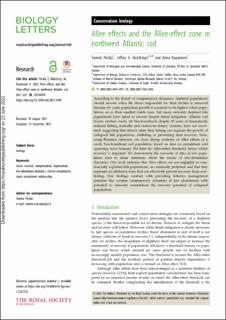| dc.description.abstract | According to the theory of compensatory dynamics, depleted populations should recover when the threat responsible for their decline is removed because per capita population growth is assumed to be highest when populations are at their smallest viable sizes. Yet, many seriously depleted fish populations have failed to recover despite threat mitigation. Atlantic cod (Gadus morhua) stocks off Newfoundland, despite 30 years of dramatically reduced fishing mortality and numerous fishery closures, have not recovered, suggesting that drivers other than fishing can regulate the growth of collapsed fish populations, inhibiting or preventing their recovery. Here, using Bayesian inference, we show strong evidence of Allee effects in a south Newfoundland cod population, based on data on recruitment and spawning stock biomass. We infer the Allee-effect threshold, below which recovery is impaired. We demonstrate the necessity of data at low population sizes to make inferences about the nature of low-abundance dynamics. Our work indicates that Allee effects are not negligible in commercially exploited fish populations, as commonly projected, and that they represent an inhibitory force that can effectively prevent recovery from overfishing. Our findings contrast with prevailing fisheries management practices that assume compensatory dynamics at low abundances with potential to seriously overestimate the recovery potential of collapsed populations. | en_US |
